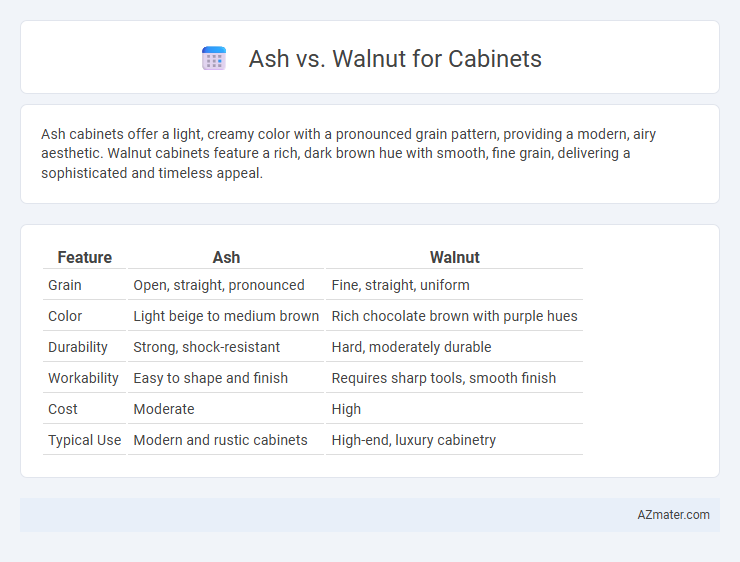Ash cabinets offer a light, creamy color with a pronounced grain pattern, providing a modern, airy aesthetic. Walnut cabinets feature a rich, dark brown hue with smooth, fine grain, delivering a sophisticated and timeless appeal.
Table of Comparison
| Feature | Ash | Walnut |
|---|---|---|
| Grain | Open, straight, pronounced | Fine, straight, uniform |
| Color | Light beige to medium brown | Rich chocolate brown with purple hues |
| Durability | Strong, shock-resistant | Hard, moderately durable |
| Workability | Easy to shape and finish | Requires sharp tools, smooth finish |
| Cost | Moderate | High |
| Typical Use | Modern and rustic cabinets | High-end, luxury cabinetry |
Introduction: Ash vs Walnut for Cabinetry
Ash and walnut are popular hardwoods for cabinetry, prized for their durability and distinctive grain patterns. Ash features a light, creamy color with bold, straight grain, offering a modern, airy look ideal for bright spaces. Walnut is known for its rich, dark brown hues and smooth texture, providing a luxurious and warm aesthetic that enhances traditional or contemporary cabinetry designs.
Wood Characteristics: Ash and Walnut
Ash wood displays a light, creamy color with a straight grain and exceptional hardness, making it highly durable for cabinet construction. Walnut features rich, dark brown hues with intricate grain patterns, offering both elegance and moderate hardness suited for refined cabinetry. Both woods provide excellent stability, but ash's lighter tone contrasts beautifully with walnut's deep, warm appearance in cabinet design.
Color and Grain Differences
Ash cabinets feature a light, creamy color with pronounced, open grain patterns that create a natural and rustic aesthetic. Walnut offers a rich, deep brown hue with subtle, straight grain lines that provide a smooth and elegant appearance. The contrast between ash's lighter tone and bold grain versus walnut's darker shade and refined grain makes each wood uniquely suited for different design styles.
Durability and Strength Comparison
Ash wood offers exceptional durability and strength, known for its ability to withstand heavy use and resist wear, making it ideal for high-traffic cabinetry. Walnut, while slightly less hard than ash, provides strong structural integrity combined with natural resistance to decay, favored for its rich aesthetics and reliable longevity. Both woods deliver excellent performance in cabinet construction, with ash excelling in impact resistance and walnut offering a balanced blend of toughness and elegance.
Workability and Finish
Ash and walnut are popular cabinet woods known for their distinctive workability and finish qualities. Ash offers excellent workability due to its straight grain and moderate density, making it easy to cut, shape, and sand, while walnut's fine grain and medium hardness provide a smooth surface ideal for detailed joinery and carving. Walnut's natural dark, rich tones enhance finishes with deep luster, whereas ash's lighter color accepts stains well, allowing versatile finishes that highlight its bold grain patterns.
Cost Analysis: Ash vs Walnut Cabinets
Ash cabinets generally offer a cost-effective alternative to walnut, with prices often 30-50% lower due to the abundance and faster growth rate of ash trees compared to walnut's slower-growing, premium hardwood. Walnut cabinets are prized for their rich color and durability, which contributes to higher market value and long-term investment appeal despite the steeper initial cost. In budget-sensitive projects, ash provides a strong balance of aesthetics and strength, while walnut suits high-end applications demanding luxury and exclusivity.
Design Styles and Aesthetic Appeal
Ash wood cabinets offer a light, natural grain that complements modern and Scandinavian design styles, enhancing spaces with a clean, airy aesthetic. Walnut cabinets, known for their rich, deep hues and intricate grain patterns, bring warmth and sophistication suited to traditional, mid-century modern, and contemporary interiors. Combining both woods can create striking contrasts, balancing brightness and depth to elevate the overall visual appeal of cabinetry.
Maintenance and Longevity
Ash cabinets offer excellent durability and straightforward maintenance, with their open grain structure allowing for easy refinishing and repair, making them ideal for high-traffic kitchen environments. Walnut cabinets, known for their rich, dark color and fine grain, require more careful maintenance to prevent scratches and water damage but provide exceptional longevity when properly cared for through regular conditioning and gentle cleaning. Both woods can last decades, but ash generally demands less intensive upkeep, while walnut rewards diligent maintenance with enduring beauty and strength.
Environmental Impact and Sustainability
Ash wood, known for its rapid growth and renewability, offers a more sustainable option for cabinets compared to walnut, which grows slower and is less abundant. The lighter carbon footprint of ash harvesting and processing reduces overall environmental impact, making it preferable for eco-conscious consumers. Walnut's durability and rich color come at the cost of greater resource consumption and longer regeneration cycles, highlighting sustainability challenges in its use.
Choosing the Best Wood for Your Cabinets
Ash offers a light, uniform grain with excellent durability and shock resistance, making it ideal for contemporary and rustic cabinet designs. Walnut features rich, dark tones and a smooth texture that adds elegance and warmth to luxury cabinetry but tends to be softer and more expensive than ash. Selecting between ash and walnut depends on your budget, desired aesthetic, and the cabinet's usage, with ash preferred for hardness and affordability, while walnut suits premium, visually striking applications.

Infographic: Ash vs Walnut for Cabinet
 azmater.com
azmater.com